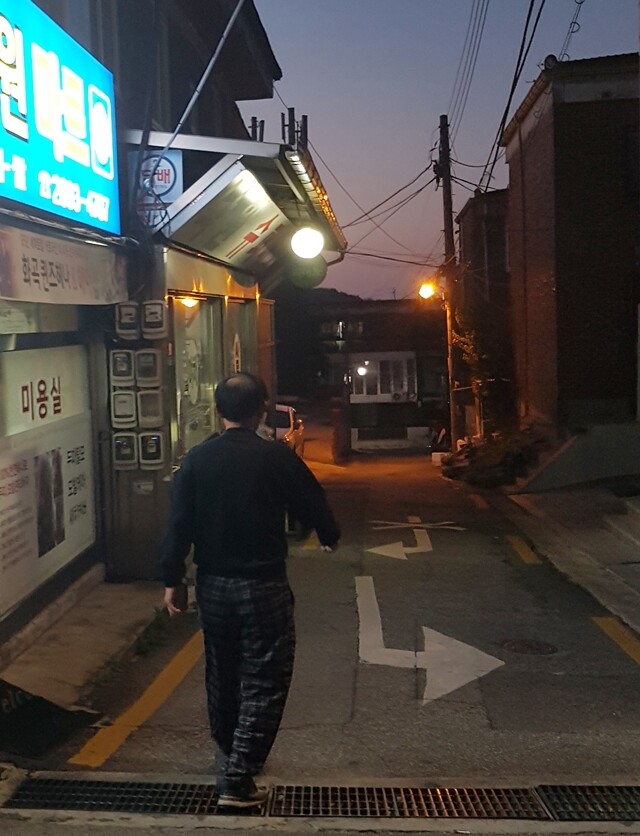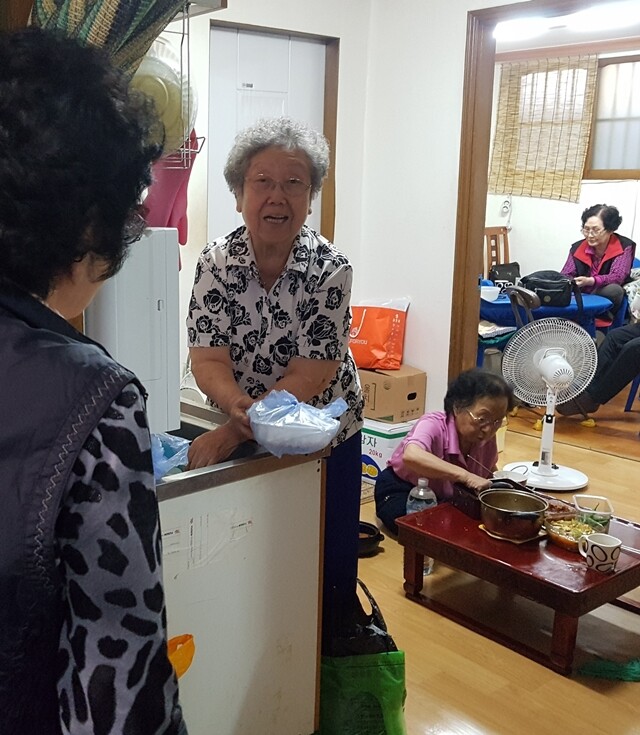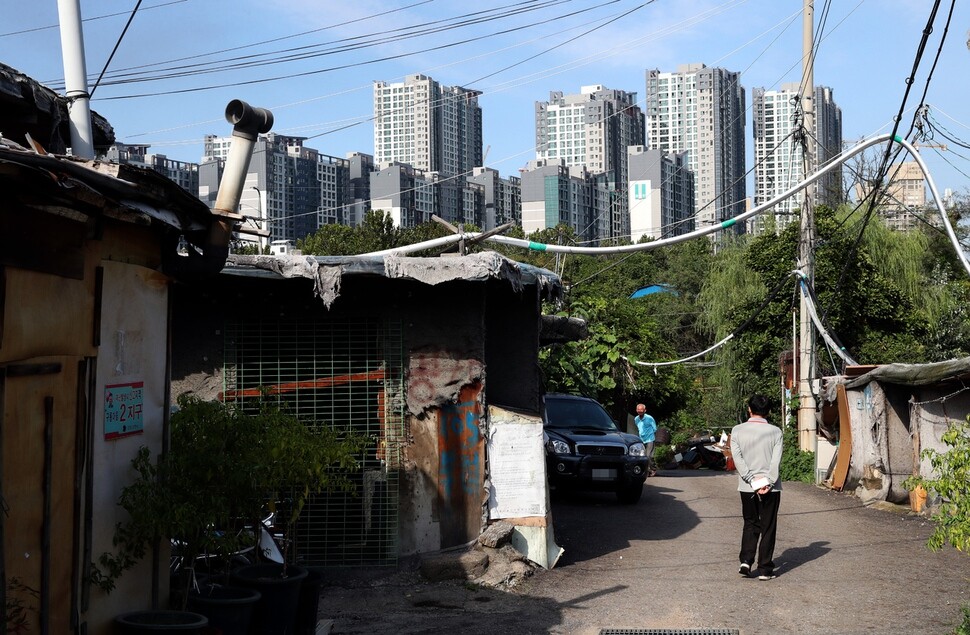hankyoreh
Links to other country sites 다른 나라 사이트 링크
[Reportage] The grim truth behind Seoul’s rise of single-person households

Seoul’s Gangseo District has the city’s second largest population of single-person households after Gwanak District (106,865). Purely in terms of age groups, Dobong District has the highest percentage of people over 60 living alone among single-percent households in Seoul. But Gangseo has the highest total number of people over 60 who live on their own. On the streets of the Hwagok No. 1 neighborhood – home to the largest number of single-person households as tallied by the Gangseo District Office last August – strollers are more often seen empty and being pushed by physically enfeebled senior citizens than with children in them.
According to Statistics Korea figures from last year, the number of over-60 people living alone totaled 8,724. In Gangseo, where the highest number live, the activities of middle-aged and elderly people are limited. It forms a sharp contrast with the single-person households made up of young people looking to live in a neighborhood with more affordable housing and prices and convenient transportation, even if it places them a bit far afield from their jobs, schools, and private academies. The middle-aged and elderly single-person household members encountered by the Hankyoreh reporters tended not to live far from the markets they rely on for work and meals.
“The current Hwagok No. 1 neighborhood was formed by combining the previous Hwagok No. 1 and No. 7 neighborhoods, so it has a large population and lots of rental housing, and there are consequently many senior citizens living alone there,” a Gangseo District Office official explained.
“In Seoul terms, it’s considered an out-of-the-way region, so the housing is cheaper, and it seems to have formed a unique environment with the many seniors who have gone to live there,” the official said.

10 employment agencies for temporary work in Hwagok Station area alone
Numerous employment agencies are clustered near Hwagok Subway Station (Line 5) and Sinwol Junction in the Yangcheon District, which borders Gangseo District. The structure is one where supply has risen in areas with a large demand for the kind of temporary work that can be found relatively easily even for people of advanced ages with limited skills. Over 10 agencies were located in the Hwagok Station vicinity alone. Job types were divided along gender lines, with women using agencies for housekeeping and cleaning work and men using others for construction work.
“It’s right next to Gangseo, so people over 60 come in up to 30 to 40 at a time,” said Mr. Ha, the 63-year-old director of a construction employment agency in Yangcheon.
“But about seven out of every 10 people over 60 are too enfeebled and can’t find work,” Ha added.
“They come out at 5 in the morning to wait their turn. It’s heartbreaking to see them go back home without finding anything,” he said.
At 5:30 that afternoon, a 69-year-old surnamed Park visited a Gangseo construction employment agency after finishing work. He was there to pick up his pay. Park earned 130,000 won (US$115) that day cleaning up materials at construction sites. He has been finding single-day odd jobs through the agency for over four years. In the past, he worked as a welder, but the work dried up as he got older. His latest temporary job lasted only until Oct. 5. As of next week, he has nothing scheduled – which means his income stream has dried up.
As he approaches his 70s, Park is nearing the end of the road as a viable candidate for construction work. A person’s sixties are seen as a borderline decade on construction sites. Employers tend to shun workers in that age group because of the losses companies could face if they are hurt on the job.
“The bigger construction sites just don’t accept people over 70 at all,” explained a staff member at another construction employment agency in Gangseo.
The places where people in their 60s are able to work are small-scale construction sites where local multiplex and multi-household housing is being built. Even there, they work odd jobs such as organizing construction materials and sweeping. As a welder, Park at least has good skills and has been able to weather the situation longer than others. When an odd job shows up, the agency calls him up to let him know. But even that work has dropped off, leaving him working odd jobs. Just before he arrived to pick up his pay, one of the agency staffers was on the phone with a staff member at a different construction site, promising to “send someone young.”
The elderly’s preference for traditional markets over convenience stores and supermarketsOn his way home, Park cut across Hwagok’s traditional market. This is where he stops around once a week. He tends not to visit supermarkets or convenience stores, which are expensive and difficult for him to use. Few of the middle-aged and elderly people living in single-person households had cars. Instead, they typically visited traditional markets within walking distance after work – getting a stroll in the bargain.
Gangseo District currently has six registered traditional markets. The number rises to over 10 when unregistered markets are added in. The area has many markets where middle-aged and elderly people living alone can walk to do their shopping; to date, they have remained a relatively stable presence. Park tended to buy mostly pre-prepared side dishes instead of ingredients for cooking. The traditional market in question had many stores selling side dishes marked as “three for 5,000 won (US$4.40).”
A divorcee, Park has lived on his own for over 20 years. His cooking has improved enough that he can prepare dishes that aren’t exactly delicious, but suit his palate. His meal this evening was doenjangguk (soybean paste soup). On days when he works, Park has just one meal at home in the evening; breakfast and lunch are eaten at the construction site. He rarely orders delivery food, which is expensive and usually too much for him to eat alone.
“When the older male customers come to shop on their own, they usually buy small quantities of side dishes to go. In many cases, they’ll buy one or two days’ worth of some kind of stew like yukgaejang (spicy beef soup),” said Park Gil-ja, manager for the Hwagok Central Street Market Merchants’ Association.
“Traditional markets are more than just places for middle-aged and elderly people living on their own to buy groceries – they’re also a social setting where people check in on each other and chew the fat,” she added.
After crossing the market, Park boarded a village bus. It is usually 5 o’clock in the morning when he leaves for the employment office. The bus does not run at that time, so he walks the distance. But by the time he is heading home, his energy is flagging. His home was six stops away from the employment agency. Park had lost some strength since his fifties and early sixties. His drained body sank into one of the bus’s designated seats for the elderly and infirm.
A lonely homePark lives on the second floor of a multiplex housing residence rented out by the Seoul Housing and Communities Corporation (SH). He is not yet at the point where he struggles to climb the stairs, but he wants to look into another multiplex residence that has elevators – in preparation for his seventies and eighties, when his knees may ache too much to climb up and down stairs.
His home consists of three rooms with a kitchen and bathroom. One of the rooms had a single bed that touched the walls on either side. A slightly larger room had a television and wardrobe inside. This is where he usually lies on the floor when he isn’t leaving the house to meet with his friends or brothers.
The third room had a refrigerator and dining table in it. In the freezer were frozen leftover side dishes. Half-drunk bottles of soju (rice liquor) and eggs were neatly arranged in the fridge. One of the shelves was occupied by a canister of ripe kimchi provided by friends. Handmade tea and two bottles of red ginseng were there for his health. Park headed to the grocery store across from his home to buy a bottle of soju to drink with his dinner.
“About a third of my friends live alone. I’m pretty sure I’m going to be living on my own from here on out,” Park said.
“There’s a woman I’ve been seeing, but we live separately. I’ve been living alone for a long time now, and I think I would uncomfortable living with someone else.”
When one is too old to workThe sixty-somethings living alone are “still babies” to their eighties-something counterparts whose bodies have begun to betray them. The children’s playgrounds served also as playgrounds for single senior citizens in their 70s and 80s. The playgrounds would have abandoned chairs neatly gathered on one side. The exercise equipment there was the only kind available to them. Still in his 60s, Park often hiked up in the mountains behind his home. But the older single seniors had fewer and fewer options for physical activity.
At the same time, they also have to work as long as their bodies allow it. Many said some version of “I want to work until it’s too difficult for me.” To reduce the burden on their children raising children of their own, and to avoid wearing out their welcome, they try to keep their rusting bodies constantly in motion.
Mrs. Kim is an 82-year-old who raised her children on her own after being widowed in her forties, and who has lived on her own since her fifties. She worked in a restaurant washing dishes until her sixties. She also prepared food for even older people at the senior citizen center. In her 70s, she did street cleaning as a public job.
Her current job - which will likely be her last – involves delivering packed lunches produced by a civil relief organization. Two days a week, she delivers the lunches to elderly men and women.
“It was a ‘seniors looking after each other’ sort of thing,” she explained.
“As someone living on my own, it’s even sadder to see the homes of seniors who are too infirm to get around, and how moldy and messy they are,” she said.
But even the packed lunch delivery service had an age limit of 85 – due to concerns about people being seriously injured during deliveries.
“Until I was 85, I worked at the same relief organization as Mrs. Kim making food for the packed lunches, but now I’m too old to work,” said Mrs. Park, an 87-year-old visiting the playground that day.
“My arms and legs work just fine, but nobody wants me,” she lamented.
On that day, Mrs. Kim had a total of five homes to deliver lunches to. She put the meals in a wheeled shopping basket and set off. The first stop was a rooftop unit in a three-story multiplex residence, home to a man in his eighties. It was the only rooftop home on the delivery route. A container box had been added to the room to serve as a kitchen. Mrs. Kim’s breath became increasingly labored as she climbed the more than 30 steps. The resident in his 80s – who has yet to visit the senior citizens’ center – received his lunch.

The second stop was the home of a couple in their 70s. Once again, the door was locked. At this hour, the two of them would be out collecting scrap cardboard. Dozens of paper boxes were piled up in from of their unit. The neighborhood had a number of junk shops buying and selling scrap paper – five to six of them at one Hwagok No. 1 intersection alone.
“The seniors collect scrap paper as a way to pass the time. It isn’t going to do much for their livelihood, since a full hand cart’s worth of it won’t even fetch them 5,000 won [around US$5],” said a 69-year-old surnamed Kim who runs one of the shops.
“Some of the seniors sell scrap paper every day, and other gather it up and come in once a week,” Kim said. A baby carriage used for collecting scrap paper could be seen chained to the fence in one of the Hwagok playgrounds that day.
The last stop on the delivery route that day was the home of 86-year-old Mrs. Lee, who lives on the first floor of a multiplex residence. Inside her room was a wheelchair. Even the three steps on the building’s first floor were an obstacle for Mrs. Lee, who struggles with age-related infirmities. Gathered at her home that day were three others of a similar age who had come to play the card game hwatu; the group had become friends while chatting at a nearby playground and senior citizens’ center.
The Yechon Senior Citizens Center in Hwagok No. 1 is the neighborhood’s most heavily frequented senior citizens’ center. The average number of users alone totals over 70 – as much as four times higher than the 18 to 49 users on average at other nearby senior meeting centers.
“It’s mainly seniors in their 70s and 80s who gather at the centers to talk and ease their loneliness,” said center chairperson Kim Gap-soon.
Having finished her lunch delivery rounds earlier that day, Mrs. Kim murmured, “I’m scared that if I keep living on my own, I might die alone and no one will even know.”
By Joh Yun-yeong, staff reporter
Please direct comments or questions to [english@hani.co.kr]

Editorial・opinion
![[Column] Has Korea, too, crossed the Rubicon on China? [Column] Has Korea, too, crossed the Rubicon on China?](https://flexible.img.hani.co.kr/flexible/normal/500/300/imgdb/original/2024/0419/9317135153409185.jpg) [Column] Has Korea, too, crossed the Rubicon on China?
[Column] Has Korea, too, crossed the Rubicon on China?![[Correspondent’s column] In Japan’s alliance with US, echoes of its past alliances with UK [Correspondent’s column] In Japan’s alliance with US, echoes of its past alliances with UK](https://flexible.img.hani.co.kr/flexible/normal/500/300/imgdb/original/2024/0419/2317135166563519.jpg) [Correspondent’s column] In Japan’s alliance with US, echoes of its past alliances with UK
[Correspondent’s column] In Japan’s alliance with US, echoes of its past alliances with UK- [Editorial] Does Yoon think the Korean public is wrong?
- [Editorial] As it bolsters its alliance with US, Japan must be accountable for past
- [Guest essay] Amending the Constitution is Yoon’s key to leaving office in public’s good graces
- [Editorial] 10 years on, lessons of Sewol tragedy must never be forgotten
- [Column] A death blow to Korea’s prosecutor politics
- [Correspondent’s column] The US and the end of Japanese pacifism
- [Guest essay] How Korea turned its trainee doctors into monsters
- [Guest essay] As someone who helped forge Seoul-Moscow ties, their status today troubles me
Most viewed articles
- 1[Column] The clock is ticking for Korea’s first lady
- 2Hong Se-hwa, voice for tolerance whose memoir of exile touched a chord, dies at 76
- 3After 2 months of delayed, denied medical care, Koreans worry worst may be yet to come
- 4[Column] Has Korea, too, crossed the Rubicon on China?
- 5Samsung barricades office as unionized workers strike for better conditions
- 6US overtakes China as Korea’s top export market, prompting trade sanction jitters
- 7All eyes on Xiaomi after it pulls off EV that Apple couldn’t
- 8[Guest essay] How Korea turned its trainee doctors into monsters
- 9[Editorial] As it bolsters its alliance with US, Japan must be accountable for past
- 10[Correspondent’s column] In Japan’s alliance with US, echoes of its past alliances with UK